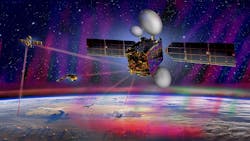U.S. Space Force reaches out to industry for companies able to adapt 5G wireless networking to space uses
EL SEGUNDO, Calif. – U.S. Space Force communications experts are reaching out to industry to find companies able to adapt 5G networking, RF and microwave access, mobility support, and related big data functions to U.S. space systems.
Officials of the Cross Mission Ground and Communications Enterprise (ECX) of the U.S. Space Force's Space and Missile Systems Center at Los Angeles Air Force Base in El Segundo, Calif., issued a request for information (FA8806) earlier this month for the 5G for Space Data Transport (SDT) project.
Space Force experts are looking for ways to capitalize on rapidly emerging 5G technologies to move data quickly and securely among military forces and command authorities through space networks.
Of particular interest are technologies involving 5G multiple-input and multiple output (MIMO); space millimeter waves; radio-access network slices; network slice orchestration; artificial intelligence (AI), machine learning, and deep learning; trusted autonomous networks; cyber security; 5G internet of space things (IoST); multi-tenant edge computing (MEC); 5G space-to-ground networks; and space network topologies.
Related: What 5G means to the military
MIMO seeks to enhance communications links between Earth and U.S. satellites, as well as communications links among satellites. Millimeter wave technology seeks to determine how small and inexpensive high-gain array antennas and 5G data links operating from 24 to 71 GHz provide data networking in space.
Radio access network slicing seeks to determine how to adapt 5G network slicing to connecting a space operations center through ground-based networks into a space network and then to specific satellites.
Network slice orchestration seeks to find ways for the government to employ 5G cloud-based and hybrid network slices to manage dozens, hundreds, or potentially even thousands of space network slices.
AI, machine learning, and deep learning seeks to determine which 5G AI and machine-learning tools could recognize message streams and analyze content to rank data streams by content type. This could enable experts to store data in a multi-tenant edge computing node and send it later.
Trusted autonomous networks seeks to enable Space Force experts to look ahead to 6G intelligent radio, cognitive radio, autonomic networking, and network orchestration.
Cyber security seeks to determine which 5G cyber security could protect complex space networks from unauthorized access and manipulation. Space Force officials also want to learn industry capabilities in 5G Internet of Space Things enabling technologies.
Multi-tenant edge computing seeks to discover the best opportunities for this technology in space and in ground-support networks. Network topologies, meanwhile, seek to determine the right mix of copper, optical fiber and free-space lasers for building-out ground networks.
Companies interested should email responses no later than 18 March 2021 to the Space Forces's Lakisha Porter at [email protected].
Email questions or concerns to Lakisha Porter at [email protected], or to Helen Bloomfield at [email protected].
More information is online at https://beta.sam.gov/opp/8edcadbb56764ca1a53f7cf6322c76d5/view.

John Keller | Editor-in-Chief
John Keller is the Editor-in-Chief, Military & Aerospace Electronics Magazine--provides extensive coverage and analysis of enabling electronics and optoelectronic technologies in military, space and commercial aviation applications. John has been a member of the Military & Aerospace Electronics staff since 1989 and chief editor since 1995.

